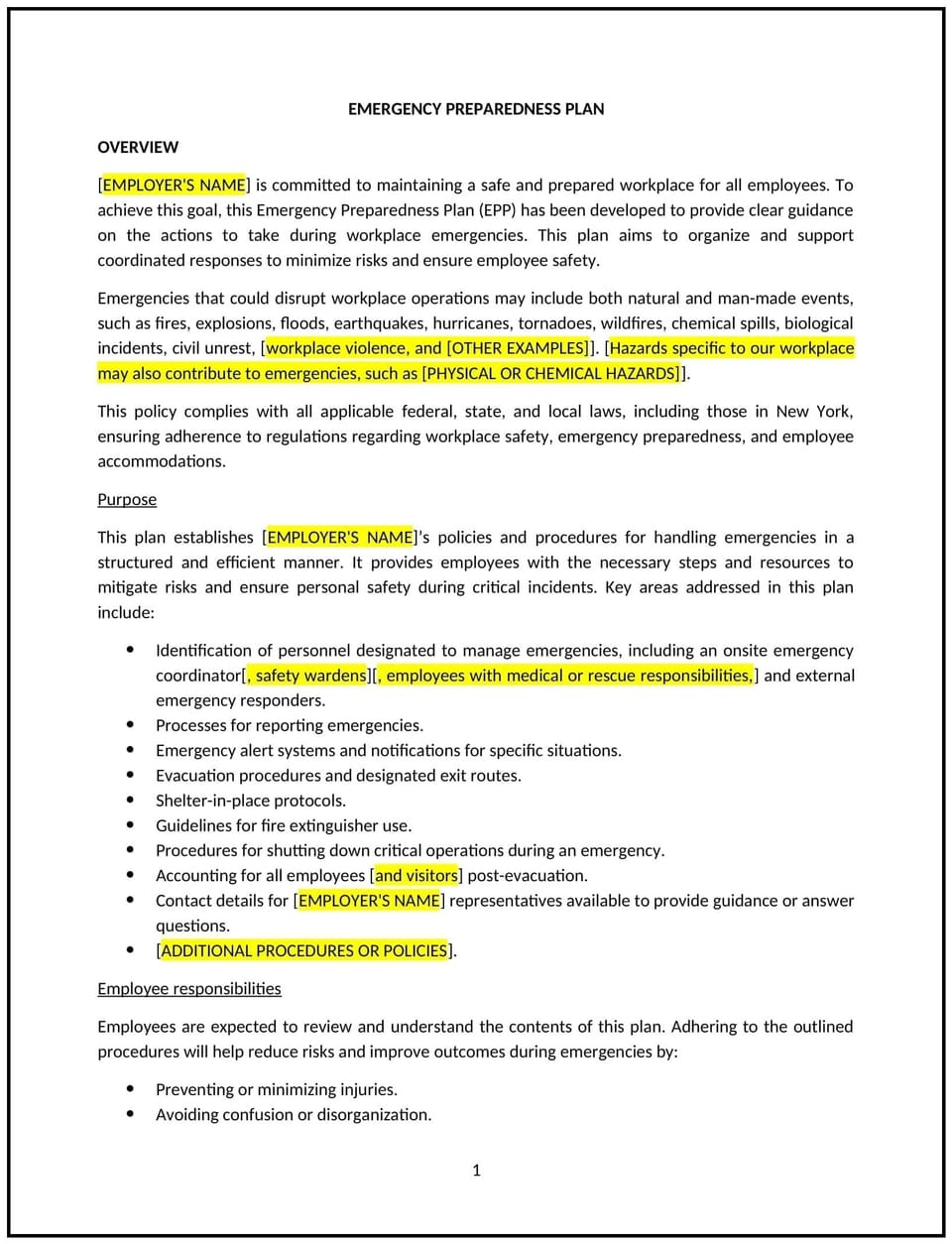Emergency preparedness plan (New York): Free template

Emergency preparedness plan (New York)
This emergency preparedness plan is designed to help New York businesses establish comprehensive guidelines for responding to emergencies. Whether businesses are preparing for natural disasters, workplace accidents, or other unforeseen events, this template ensures key components are addressed to protect employees, customers, and operations.
By using this template, businesses can enhance safety, minimize disruption, and demonstrate a commitment to proactive risk management.
How to use this emergency preparedness plan (New York)
- Conduct a risk assessment: Identify potential risks specific to the business location, such as severe weather, power outages, or fire hazards, and outline how these risks will be addressed.
- Define emergency roles and responsibilities: Specify who is responsible for executing different parts of the plan, including communication, evacuation, and first aid.
- Establish communication protocols: Develop clear communication procedures for alerting employees, customers, and emergency services in the event of an emergency.
- Plan for evacuation and shelter-in-place: Include detailed evacuation routes, assembly points, and shelter-in-place instructions tailored to the business’s physical layout.
- Incorporate recovery strategies: Outline steps for resuming operations after an emergency, including assessing damage, restoring essential services, and supporting employees.
Benefits of using an emergency preparedness plan (New York)
This plan offers several benefits for New York businesses:
- Enhances employee safety: By identifying risks and preparing responses, businesses can reduce the likelihood of injuries during emergencies.
- Minimizes operational downtime: A well-designed plan helps businesses quickly recover and resume normal operations after an incident.
- Protects assets: The plan includes measures to safeguard property, inventory, and critical data, minimizing financial losses.
- Demonstrates accountability: Businesses with an emergency preparedness plan show a commitment to the well-being of employees, customers, and the community.
- Reduces liability: Proactively planning for emergencies helps mitigate legal risks associated with workplace safety.
Tips for using this emergency preparedness plan (New York)
- Tailor the plan to the business: Customize the plan based on the size, location, and specific risks of the business to ensure relevance.
- Train employees: Provide regular training sessions so employees are familiar with their roles and responsibilities during an emergency.
- Test the plan: Conduct drills and simulations to identify gaps in the plan and improve overall preparedness.
- Collaborate with local resources: Establish relationships with local emergency services, such as fire departments and law enforcement, to enhance coordination during emergencies.
- Regularly review and update: Ensure the plan remains current by reviewing it annually or after significant changes to the business or regulatory environment.
Q: What types of emergencies should this plan cover?
A: The plan should address a range of emergencies, including natural disasters (e.g., floods, hurricanes), workplace incidents (e.g., fires, chemical spills), and security threats.
Q: How often should businesses conduct emergency drills?
A: Drills should be conducted at least annually, but more frequent drills may be necessary for high-risk industries or locations.
Q: Who should be involved in creating the plan?
A: The plan should be developed with input from management, employees, and, if applicable, safety consultants or external experts.
Q: Are businesses required to have an emergency preparedness plan in New York?
A: While specific requirements vary by industry, having a plan is a best practice for all businesses and may be required by certain regulatory standards.
Q: How can businesses support employees during recovery?
A: Businesses can provide resources such as counseling services, financial assistance, or flexible work arrangements to help employees recover from the impacts of an emergency.
This article contains general legal information and does not contain legal advice. Cobrief is not a law firm or a substitute for an attorney or law firm. The law is complex and changes often. For legal advice, please ask a lawyer.


